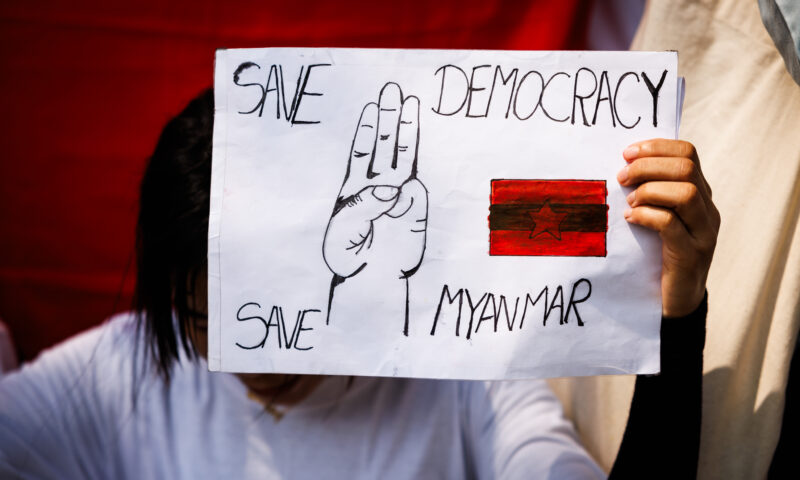Judging Janus
Judging Janus: Wisconsin’s Shadow
Co-published by AlterNet
Wisconsin provided early examples of scorched-earth labor policies. California unions took note.

The financial pressure from a pro-Janus
ruling will hamper unions from taking lead roles in policy debates on such issues as health care.
Mark Janus, an Illinois child-support worker, will soon argue before the U.S. Supreme Court that his free speech rights have been violated because he must pay “agency fees” to a union that, inter alia, negotiates contracts on his behalf. Last year California elementary school teacher Rebecca Friedrichs made the same First Amendment arguments at the high court against the teachers association to which she paid agency fees. The court deadlocked on Friedrichs’ complaint following the death of conservative Justice Antonin Scalia, but his replacement, Justice Neil Gorsuch, is widely expected to cast a decisive vote in favor of Janus and against public-sector unions.
Co-published by AlterNet
Should Mark Janus prevail in his Supreme Court case, public-sector employees in California and other states who now pay agency fees instead of union dues will be able to opt out of any payment at all—even though they can still benefit from collective bargaining contracts and turn to the union with grievances, enjoying a free ride that drains union resources.
See Other Stories in This Series
The ruling would undermine the ability of public-sector unions—about half of U.S. organized labor—to set standards for wage and workplace conditions. The resulting financial pressure will hamper unions from taking lead roles in policy debates on such issues as health care. “The short-term [goal] is to reduce the ability to collect dues,” said Raphael Sonenshein, executive director of the Pat Brown Institute for Public Affairs. “The long-term aim is to weaken collective bargaining.”
Anti-union forces, often funded by corporate-backed foundations, have been on the attack for decades. One stunning victory was the 2011 passage of Wisconsin’s Act 10, that state’s “budget repair” bill. Republican Governor Scott Walker, long a vocal enemy of public-sector unions, introduced it to address a $3.6 billion budget shortfall.
By 2014 the once-robust Wisconsin State Employees Union had lost 60 percent
of its members.
Act 10 gutted public-sector union collective bargaining rights, leaving unions unable to negotiate wages—except raises attached to the cost-of-living—along with pensions, work conditions such as hours worked, sick leave and vacations. In other words, all the things that, for many, make it worth paying union dues.
The law also loosened restrictions on local governments’ hiring and wage policies, while allowing wage freezes and requiring higher employee health-care contributions.
Act 10 knee-capped labor as a political force in an historically union state — the first to recognize public-sector unions. By 2014 the once-robust Wisconsin State Employees Union had lost 60 percent of its members; its annual budget dropped from $6 million to $2 million. Then came the defections. In 2013 the nearly 6,000 prison guards staffing Wisconsin’s correctional facilities voted to leave WSEU for the newly-created Wisconsin Association for Correctional Law Enforcement, which cut dues from WSEU’s roughly $36 monthly rate to WACLE’s $18. WACLE now represents approximately 5,900 state security workers.
“The two major public-sector unions both lost about 80 percent of dues-paying members,” Joel Rogers, a University of Wisconsin, Madison professor of law and sociology, told Capital & Main. Rogers is also the founder of an organization called COWS, touted as “the national high-road strategy center” think tank. Shrunken union budgets hobbled the ability to operate effectively on policy issues and support labor-friendly candidates. “They are basically nowhere near what they were in terms of political forces,” Rogers said.
Wisconsins weren’t in a mood to pay dues to unions without collective bargaining power. So they quit—bleeding unions of funds.
Employees whose livelihoods had taken a hit with budget cuts weren’t in a mood to pay dues to a union without collective bargaining power. So they quit—bleeding unions of funds.
“Which is what it was all about,” said Rogers.
Labor’s post-Act 10 relative absence from the Wisconsin policy arena, Rogers continued, has contributed to “an across the board assault on all public goods, starting with the K-12 system and the university—that was about 1.5 billion worth of cuts—environmental deregulation, the Department of Natural Resources stripped of powers and evacuated of scientists, endless stuff on deregulation [and] corporate liabilities have been reduced–increasing pressure to privatize public goods.”
Governor Walker, Rogers added, was backed by donors not widely known outside Wisconsin, but whose political footprint extends far beyond the state. They included Diane Hendricks, who made a fortune in the roofing-supply business. A backer of Scott Walker’s presidential PAC who donated $500,000 to defeat a union-backed recall effort against the governor, she is heard here in a YouTube clip asking Walker to turn Wisconsin into a red state; he replies that the first step is dealing with public-sector bargaining.
There was also Michael Grebe, a corporate attorney and former Marine, who chaired Walker’s gubernatorial and anti-recall campaigns. He recently retired as CEO of the Bradley Foundation, which from 2001 to 2009 donated nearly as much money to ultra-conservative causes as foundations backed by the Koch Brothers and the Scaife family combined. Efforts aimed at dismantling public infrastructure included: vouchers for private schools and cutbacks in public employee benefits and collective bargaining rights.
“We’re part of the right-wing movement,” Grebe told the Milwaukee Wisconsin Journal-Sentinel. “I don’t think it’s conspiratorial.”
The Wisconsin labor organizations that are now managing to hold their ground are those that had cultivated a strong base before Act 10 and are adjusting strategies to reach their members and different constituencies.
Michael Rosen is a past president of American Federation of Teachers Local 212, which represents 1,400 faculty and professional staff. “Strong unions that were very active and had a mobilized membership were able to maintain [their] membership,” Rosen said.
Heather DuBois Bourenane of Wisconsin Public Education Network reflects on her organization’s efforts to organize at parent and teacher house meetings, to ramp up use of Facebook and other digital channels, to pack public state budget meetings and to launch postcard campaigns and write letters to news editors.
She was a mother with two kids in the school system holding down two part-time university teaching jobs and a third assistantship when Act 10 passed. She had marched against it and now has a sharpened sense of the need to be on guard. “We hope people look at us in Wisconsin and lift us up as lessons learned.”
The Golden State boasts the largest number of union members in the country at 2.6 million, with 53 percent represented by public-sector unions. The American Federation of State, County and Municipal Employees is one of the two largest; Service Employees International Union is another. Janus victorious would not be nearly as onerous for California as Act 10 was for Wisconsin, as Act 10 effectively extinguished public-sector collective bargaining. Still, Janus would provide a huge anti-labor win.
One union began to look at ZIP codes—connecting home-care workers that live within blocks of one another
but who would never meet on the job.
“Rough estimates are that within three years, 20 to 40 percent of union members would stop paying dues,” said Fred Ross, a veteran organizer with the International Brotherhood of Electrical Workers Local 1245, which represents 2,500 public-sector transit and power workers throughout California. Unions would have to operate with between 20 and 40 percent less revenue, he added.
Unions are the largest source of campaign contributions to Democratic Party legislators—many of whom support such union-backed measures as worker protections, the $15 hourly minimum wage and immigrant-rights protections, said Steve Barkan, a Los Angeles-area campaign consultant. Janus “tips the scales further toward corporate interests,” he said.
Public-sector unions were under attack in California before Janus. Labor activists like Ross have been organizing for months, some for years, to counter its potential effects. Ross’ local has developed a targeted strategy based on a volunteer organizing committee. Some 250 union member organizers are charged with building relationships with 10 other members to explain the union’s role in winning benefits and protecting rights—and signing them up as voluntary dues-paying members.
Unions for home-care workers — those paid from public funds to work in private homes caring for low-income infirm persons — got hit hard by the 2013 Harris v. Quinn decision that has similarities to the Janus case. The 5-4 Supreme Court ruling said home health-care workers didn’t have to support their unions financially.
“Harris is our Janus,” said Doug Moore, executive director of the United Domestic Workers Homecare Providers Union (UDW) and an AFSCME International Vice President. Before the Harris decision, “We had 68,000 [people] ” Moore said. “We lost 20,000 [fees-paying non-members] overnight” after the decision came down.
As the Harris decision approached, the union went into high-gear to connect with its base. Most of the millions of homecare workers in the U.S. are women of color; about one-quarter live below the poverty line and more than half need public assistance to get by.
The UDW created focus groups that discovered the home-care workers’ main concern was being able to obtain more hours for severely infirm clients like those with Alzheimer’s. Staff expanded existing efforts at In-Home Supportive Services worker orientation sessions in 21 counties around the state to make presentations. There were house visits, efforts to match Facebook profiles to email, a button on the website to sign up, going paperless and doing sign-ups via tablet—anything that would engage and listen to members, and convey the value of the union. There are now 72,000 dues-paying members — approaching double the UDW’s pre-Harris level.
The same story applied to SEIU Local 2015, which also represents public-sector home-care workers. Harris threatened Local 2015’s voluntary membership rates. The union began to look at ZIP codes—connecting homecare workers that live within blocks of one another but would never meet on the job. Facebook and Twitter helped. Membership increased by 48 percent, said Kim Evon, a Local 2015 vice-president. “Our demographic tends to be 70 percent women of color—and the average age is 55. We make a lot of assumptions that they are not plugged in but they are. Mail is that thing that piles up and gets stuck in the circulars from Vons.”
In a September organizing blitz, 16 different Southern California unions approached adjunct faculty at East Los Angeles College to join the California Federation of Teachers; meanwhile, SEIU 99, which organizes non-professional campus workers, informed child care providers of the benefits of belonging to a union. Private-sector janitors and security guards and other workers visited public-sector workers who are going to be impacted by Janus.
Alfonso Garcia was one of them. A union member since 1987, Garcia is currently an organizer for United Steelworkers Local 675, and has talked to part-time teachers, childcare providers and homecare workers in their homes to explain what a union does—about benefits, job security and meeting with management. “One voice, that’s just one person,” he said. “One thousand—that’s a better voice. The union gives us a voice.”
Several of the unions cited or quoted in this series are financial contributors to Capital & Main.
Copyright Capital & Main

-

 Locked OutDecember 23, 2025
Locked OutDecember 23, 2025Section 8 Housing Assistance in Jeopardy From Proposed Cuts and Restrictions
-

 Latest NewsDecember 22, 2025
Latest NewsDecember 22, 2025Trump’s War on ICE-Fearing Catholics
-

 Column - State of InequalityDecember 24, 2025
Column - State of InequalityDecember 24, 2025Where Will Gov. Newsom’s Evolution on Health Care Leave Californians?
-

 Latest NewsJanuary 8, 2026
Latest NewsJanuary 8, 2026Why No Charges? Friends, Family of Man Killed by Off-Duty ICE Officer Ask After New Year’s Eve Shooting.
-

 Latest NewsDecember 29, 2025
Latest NewsDecember 29, 2025Editor’s Picks: Capital & Main’s Standout Stories of 2025
-

 Latest NewsDecember 30, 2025
Latest NewsDecember 30, 2025From Fire to ICE: The Year in Video
-

 Column - State of InequalityJanuary 1, 2026
Column - State of InequalityJanuary 1, 2026Still the Golden State?
-

 Latest NewsJanuary 6, 2026
Latest NewsJanuary 6, 2026In a Time of Extreme Peril, Burmese Journalists Tell Stories From the Shadows

